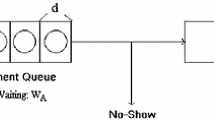Abstract
Many service systems are appointment-driven. In such systems, customers make an appointment and join an external queue (also referred to as the “waiting list”). At the appointed date, the customer arrives at the service facility, joins an internal queue and receives service during a service session. After service, the customer leaves the system. Important measures of interest include the size of the waiting list, the waiting time at the service facility and server overtime. These performance measures may support strategic decision making concerning server capacity (e.g. how often, when and for how long should a server be online). We develop a new model to assess these performance measures. The model is a combination of a vacation queueing system and an appointment system.
Similar content being viewed by others
References
Bini, D., Meini, B., & Steffe, S. & Van Houdt, B. (2006). Structured Markov chains solver: algorithms. In ACM international conference proceeding series, Proceedings of SMCtools, Pisa, Italy.
Bitran, G., & Tirupati, D. (1991). Approximations for networks of queues with overtime. Management Science, 37, 282–300.
Cayirli, T., & Veral, E. (2003). Outpatient scheduling in health care: a review of literature. Production and Operation Management, 12, 519–549.
Doshi, B. T. (1986). Queueing systems with vacations—a survey. Queueing Systems, 1, 29–66.
Dudewicz, E. J., & Mishra, S. N. (1988). Modern mathematical statistics. New York: Wiley.
Ho, C., & Lau, H. (1992). Minimizing total cost in scheduling outpatient appointments. Management Science, 38, 1750–1764.
Ho, C., & Lau, H. (1999). Evaluating the impact of operating conditions on the performance of appointment scheduling rules in service systems. European Journal of Operational Research, 112, 542–553.
Khinchin, A. J. (1960). Mathematical methods in the theory of queueing. New York: Hafner.
Lambrecht, M. R., Ivens, P. L., & Vandaele, N. J. (1998). ACLIPS: a capacity and lead time integrated procedure for scheduling. Management Science, 44, 1548–1561.
Lariviere, M. A., & Van Mieghem, J. A. (2004). Strategically seeking service: how competition can generate Poisson arrivals. Manufacturing & Service Operations Management, 6, 23–40.
Latouche, G., & Ramaswami, V. (1999). Introduction to matrix analytic methods in stochastic modeling. ASA-Series on Statistics and Applied Probability. Philadelphia: SIAM
Liao, C., Pegden, C. D., & Roshenshine, M. (1993). Planning timely arrivals to a stochastic production or service system. IIE Transactions, 25, 63–73.
Mondschein, S. V., & Weintraub, G. Y. (2003). Appointment policies in service operations: a critical analysis of the economic framework. Production and Operations Management, 12, 266–286.
Neuts, M. F. (1981). Matrix-geometric solutions in stochastic models. Baltimore: Johns Hopkins University Press.
Osogami, T. (2005). Analysis of multiserver systems via dimensionality reduction of Markov chains. Ph.D. thesis, School of Computer Science, Carnegie Mellon University.
Palm, C. (1943). Intensitätsschwankungen im Fernsprechverkehr. Ericsson Technics, 44, 1–89.
Takagi, H. (1988). Queueing analysis of polling models. ACM Computing Surveys, 20, 5–28.
Tian, N., & Zhang, Z. (2006). Vacation queueing models. New York: Springer.
Vanden Bosch, P. M., & Dietz, D. C. (2000). Minimizing expected waiting in a medical appointment system. IIE Transactions, 32, 841–848.
Vanden Bosch, P. M., & Dietz, D. C. (2001). Scheduling and sequencing arrivals to an appointment system. Journal of Service Research, 4, 15–25.
Wang, P. P. (1997). Optimally scheduling N customer arrival times for a single-server system. Computers and Operations Research, 24, 703–716.
Weiss, E. N. (1990). Models for determining estimated start times and case orderings in hospital operating rooms. IIE Transactions, 22, 143–150.
Author information
Authors and Affiliations
Corresponding author
Rights and permissions
About this article
Cite this article
Creemers, S., Lambrecht, M. Queueing models for appointment-driven systems. Ann Oper Res 178, 155–172 (2010). https://doi.org/10.1007/s10479-009-0646-9
Published:
Issue Date:
DOI: https://doi.org/10.1007/s10479-009-0646-9




